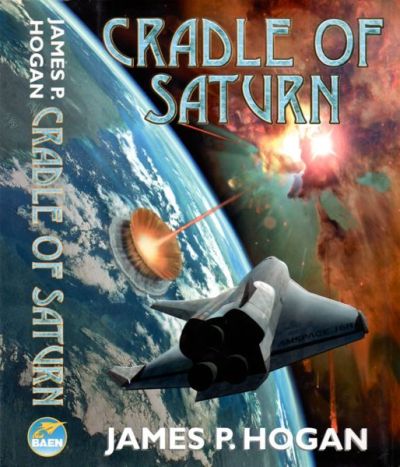Cradle of Saturn by James P. Hogan
Cradle of Saturn (Cradle of Saturn, volume 1)
By James P. Hogan

20 Jun, 2000
0 comments
Cradle of Saturn
James P. Hogan
Baen Books [1999]
421 pages
I’m a die-hard hard SF fan. HSF has never been an especially large genre and to read any amount of it, I have had to develop a certain ability to forge my way through seemingly endless crap to get my HSF fix, which is why I was able to finish James Hogan’s Cradle of Saturn . Hogan’s grasp on certain aspects of physics has never been the firmest [The orbital mechanics in his first novel, Inherit the Stars are dodgy at best] but he used to turn out readable pulp, something one could happily read sitting in the back of an old van, listening to Ian and Sylvia 8‑tracks.
It’s not uncommon for older writers to get fixated on one issue at the cost of their fiction or to suffer a general decline in their ability to write, perhaps due to age, illness or even burnout. Mr. Hogan has apparently fallen victim to both: he has become an ardent Velikovskyite and his prose has declined as well. This means that not only is the book filled with crack-pottery, it is filled with badly written crackpottery.
In Cradle of Saturn , the True History of the Solar System is the model Velikovsky proposed, as interpreted by Charles Ginenthal. The model the fusty old gradualist scientists are using is something like our current model, despite the information provided by a colony of scientists out by Saturn. That there may be bugs in the standard model becomes clear when Jupiter spits out a cosmic loogey the size of Venus but modifying the astronomical models can’t be done because it would threaten the careers of the elder astronomers and other Powers That Be.
Enter Landen Keene, a rocket scientist who has just helped build a stupendous atomic rocket, whose abilities are demonstrated as he flies rings around the new chemically power shuttles of the military. Keene falls in with the Kronians, the human colonists of the Saturnian moons. He realizes that the standard model is flawed and throughout the book gradually deduces the Ginenthal model, with the help of the son of his love interest. All of the scientific deduction is written up scenes which reminded me of the wide-eyed enthusiasm of old utopian novels like Looking Backward: 2000 – 1887 , where naïfs from our time are available to have the utopian economic systems explained to them.
Speaking of Looking Backward , Hogan also has issues with the current economic set up, preferring, if one may judge by which society is successful, some sort of left-anarchist set-up where people work hard because they can, not for monetary rewards. It’s a sad person who can only support eccentric views on only one topic and it is to Mr. Hogan’s credit that he manages to hold unusual views in several fields at once.
Much of the book is taken up with the explanation of Ginenthal’s model, complete with reduced felt-effect of gravity due to Earth’s former proximity to Saturn, the casual discarding of considerable periods of history as counterfactual, new and heretofore unobserved electromagnetic effects needed to make the planets do what the model requires, with a hint of a taste of guided evolution or so great cosmic designer. No flying feral chickens, though, whose lack made me a little sad.
To be a novel, it is generally considered desirable to have some kind of story and in this Hogan is entirely conventional. Sadly, the story is not very interesting, populated by characters who are flat even for this subgenre, even compared to previous work by Hogan. People expecting the opponents of Ginenthal’s model to drawn with the light-handed subtlety of a David Weber will be disappointed, I fear: the Sagan-equivalent only fails to be a melodrama villain due to hislack of a moustache to twirl. The adventure plot, as it become obvious
most of the people on Earth are doomed and the hero tries to rescue his love plot token and her child, trudges along like a gut-shot doughboy, eventually stumbling to a conclusion. Thank God.
To be fair, the book does have the awful attraction ofa traffic accident and seeing which of Ginenthal’s claims would make it into the book almost compensated for the tedium of the plot. This is not even the worst HSF novel I have ever read: that would be either Baxter’s Titan or his Silverhair , both of which I have reviewed elsewhere, both of which are worth thumbing out one’s eyes to avoid having to reread. Perhaps with practice Hogan might aspire to the true depths of awfulness which Baxter has conquered before him but for now, I would only be willing to break a limb to avoiding rereading Cradle of Saturn and not my own limb, either.
Recommended for insomniacs.
